
Alberta is one of the thirteen provinces and territories of Canada. It is a part of Western Canada and is one of the three prairie provinces. Alberta borders British Columbia to the west, Saskatchewan to the east, the Northwest Territories to the north, and the U.S. state of Montana to the south. It is one of the only two landlocked provinces in Canada, with Saskatchewan being the other. The eastern part of the province is occupied by the Great Plains, while the western part borders the Rocky Mountains. The province has a predominantly continental climate but experiences quick temperature changes due to air aridity. Seasonal temperature swings are less pronounced in western Alberta due to occasional Chinook winds.

The horned lark or shore lark is a species of lark in the family Alaudidae found across the northern hemisphere. It is known as "horned lark" in North America and "shore lark" in Europe.

Pieris bryoniae, the dark-veined white or mountain green-veined white, is a Palearctic butterfly of the family Pieridae.

The mountain plover is a medium-sized ground bird in the plover family (Charadriidae). It is misnamed, as it lives on level land. Unlike most plovers, it is usually not found near bodies of water or even on wet soil; it prefers dry habitat with short grass and bare ground. Its height is in the range of 5-9 inches, and length in the range of 8-10 inches ; and it weighs around 102 grams.

Lycaena phlaeas, the small copper, American copper, or common copper, is a butterfly of the Lycaenids or gossamer-winged butterfly family. According to Guppy and Shepard (2001), its specific name phlaeas is said to be derived either from the Greek φλέγω (phlégo), "to burn up", or from the Latin floreo, "to flourish".
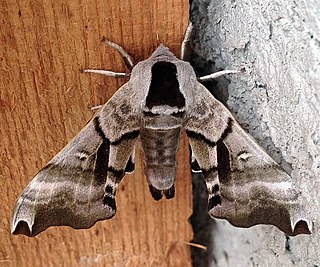
Smerinthus cerisyi, the one-eyed sphinx or Cerisy's sphinx, is a moth of the family Sphingidae. The species was first described by William Kirby who named the species in honor of Alexandre Louis Lefèbvre de Cérisy in 1837.

Smerinthus jamaicensis, the twin-spotted sphinx, is a moth of the family Sphingidae. The species was first described by Dru Drury in 1773.

Smerinthus ocellatus, the eyed hawk-moth, is a European moth of the family Sphingidae. The species was first described by Carl Linnaeus in his 1758 10th edition of Systema Naturae.

Smerinthus is a Holarctic genus of hawkmoths in the family Sphingidae. It was described by Pierre André Latreille in 1802. Adults have conspicuous eyespots on the hindwings.

Zygaena is a genus of moths in the family Zygaenidae. These brightly coloured, day-flying moths are native to the West Palearctic.

Allancastria cerisyi, the eastern festoon, is an Old World papilionid butterfly whose geographical range extends from the Balkans to include Turkey and the near Middle East. It exhibits several geographical variants.

Leptarctia is a monotypic tiger moth genus in the family Erebidae described by Stretch in 1872. Its only species, Leptarctia californiae, was described by Francis Walker in 1855. It is found in western North America, from New Mexico and Colorado to California and north to British Columbia. The habitat consists of open forests, meadows and clearings in the mountains.

Colias nastes, the Labrador sulphur, is a butterfly in the family Pieridae. In Europe, it is found in the north of Norway and Sweden and on rare occasions in northern Finland. It is also found in North America, specifically in Alaska, Canada, and the Rocky Mountains, Washington, Montana and on Greenland. In Asia, it is found in the Altai Mountains, the border regions of Russia, China, Mongolia, Kazakhstan, the Sayan Mountains, the north of Siberia, and in the Chukotka Autonomous Okrug.
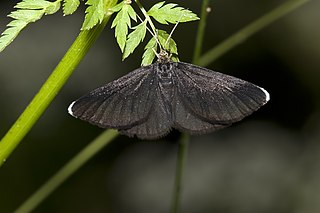
Odezia is a monotypic moth genus in the family Geometridae erected by Jean Baptiste Boisduval in 1840. Its only species, Odezia atrata, the chimney sweeper, was first described by Carl Linnaeus in his 1758 10th edition of Systema Naturae. It is found in the Palearctic.
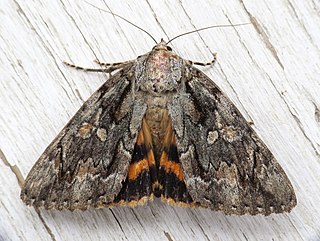
Catocala neogama, the bride, is a moth in the family Erebidae first described by James Edward Smith in 1797. It is found in North America east of the Rocky Mountains, from Maine and Quebec south to northern Florida and west to South Dakota, New Mexico, and into Arizona and Texas. Its westernmost population from the semiarid Colorado Plateau region is rather distinct and was once considered a separate species, but is now regarded as a well-marked subspecies C. n. euphemia.
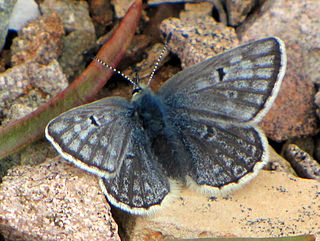
Agriades glandon, the Arctic blue or Glandon blue, is a species of butterfly in the family Lycaenidae. It in found in Eurasia and North America.

Acraea cabira, the yellow-banded acraea, is a butterfly of the family Nymphalidae that is native to Africa.
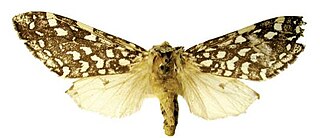
Lophocampa albiguttata is a moth of the family Erebidae. It was described by Jean Baptiste Boisduval in 1870. It is known from Honduras and possibly Mexico.

Parides sesostris, the emerald-patched cattleheart or southern cattleheart, is a species of butterfly in the family Papilionidae.

Aporophyla australis, the feathered brindle, is a moth in the family Noctuidae. The species was first described by Jean Baptiste Boisduval in 1829. It is found in western and southern Europe, North Africa and the Middle East.























